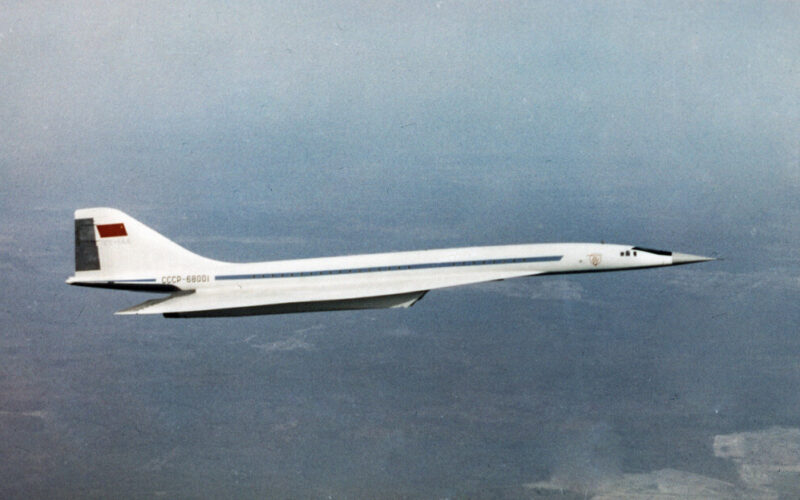Tu-144 was the first supersonic passenger aircraft developed by Tupolev Design Bureau in the 60s in the Soviet Union. Often compared to its Western counterpart, Aerospatiale / BAC Concorde, Tu- 144 was the largest and heaviest transport aircraft in aviation history that reached Mach 2.
Concorde vs Tu-144
The race for creating the first supersonic passenger plane initially started between three major aircraft constructors: USA Boeing 2707, the joint British French Concorde company, the Soviet Union, and their Tu-144. Later the Boeing left the competition due to the government funding cut.
The Soviet Union’s prime-minister, Nikita Khrushchev, was urging his engineers to make supersonic jet, which should have been quicker, carry more passengers, and be released in a shorter term.
The USSR constructors partly succeeded in their task. Created by aircraft designers Andrey N. Tupolev and his son Alexey, Tu-144 managed to beat Concorde to the skies twice. It had its maiden flight on December 31, 1968, two months before Concorde, and then achieved its first supersonic flight in June 1969, beating the competition by four months.
Engineering improvements to reach supersonic speed
To achieve supersonic flight, the engineers were working on an afterburner economical turbojet engine of the RD-36-51 type. The first pre-production modernized Tu-144 plane was folded in 1968. According to estimates, the NK-144 engines could provide a supersonic flight range of 3275 km. It was decided to build six more Tu-144s with more efficient NK-144A engines, which could reach 3500 km range flight. Modernization met the requirements for the supersonic range of the first stage (4-4.5 thousand km). Each of the power plants had its air intake located pairwise. The nose landing gear was retracted into the space of the front of the fuselage between the air intakes.

NASA Photo by Jim Ross
The second aim was to improve the aerodynamic characteristics of the Tu-144. The soviet engineers changed the shape of the wing. The wing area was increased. Was introduced an intensive conical twist of the end parts. Modernization of the central part of the wing provided self-balance in cruising speed modes. The changes affected the length of the fuselage, which could accommodate up to 150 passengers. Improving aerodynamic characteristics contributed to the processing of the shape of the nose of the fuselage.
The twin engines together with the engine nacelles were pushed apart, thereby freeing up space in the lower part of the fuselage. This led to changes in the chassis system: the main landing gear was placed under the nacelles. It was an all-metal low-wing plane, made according to the “tailless” scheme with tricycle chassis. The fuselage of the plane was made as a semi-monocoque, with stringers and a set of frames.
Such design improvements led to an increase in fuel supply and commercial load. The take-off mass of the aircraft reached up to 190 tons.
First take-off and serial production
The first test flight took place in December 1968, exceeded the speed of sound. The plane was first presented in Moscow in May 1970. In its production model Tu-144 was 65.7 meters (215.6 feet) in length, with a wingspan of 28.8 meters (94.5 feet). Its normal speed reached up to Mach 2.2, more than twice the speed of sound.
The plane contained a crew of three, a single commander, and two flight engineers. The Tu-144 carried 140 passengers onboard, with 11 in first class and 129 in the economy. The first pre-production copy of the Tu-144 was released in early 1971, and the first flight on it took place on January 6, 1971. On September 20, 1972 the plane completed a flight on the route Moscow – Tashkent, which was overcome in 1 hour 50 minutes. During the flight, the cruising speed of the jet reached 2500 km / h. The serial production of the Tu-144 airliner was established at the Voronezh Aviation Plant. Passenger compartment equipment was ordered from the GDR. The first passenger flight took place on November 1, 1977. In total, 17 copies of the Tu-144 supersonic airliners were produced, 14 of which were in Voronezh. Until May 1978, 55 passenger and 47 cargo flights were carried out on the plane.
Reasons behind the Tu-144 failure
Despite the visual similarity to Concorde, the experience of flying on the Tu-144 was not the same. It was louder, less comfortable, and sometimes even dangerous. To sustain its supersonic speeds, Tu-144 was using afterburners, like military aircraft. Such afterburners produced a lot of noise. The sound of the afterburners on Tu-144 was so loud that the passengers had to pass paper messages to each other for communication. The Tu-144 only ever flew one route, Moscow to Almaty once a week. As per experts the route was chosen because it passed over populated areas.
The flights were usually half-empty. The plane was transporting more cargo and mail than people. Moreover, Tu-144 had quite primitive technical equipment. It did not have any computers onboard and no autopilot technologies. Besides, the plane suffered from serious technical failures, including depressurization and engine failure.
On 3 June 1973, the first production aircraft crashed in front of 350 thousand spectators. The crash occurred near the small French city of Hussenville and killed the entire crew of the ship and 7 residents, 28 people were injured.
Another fatal crash happened on May 23, 1978, when the plane caught fire near Moscow and made an emergency landing. Two flight engineers were killed.
Over the next years, the program was finally stopped in 1984. Most of the Tu-144 planes were scrapped, but a few can be found on display in aviation museums in Russia and Germany.

